HONDA ACCORD SEDAN 2001 Owner's Manual (in English)
Manufacturer: HONDA, Model Year: 2001, Model line: ACCORD SEDAN, Model: HONDA ACCORD SEDAN 2001Pages: 372, PDF Size: 6.1 MB
Page 191 of 372
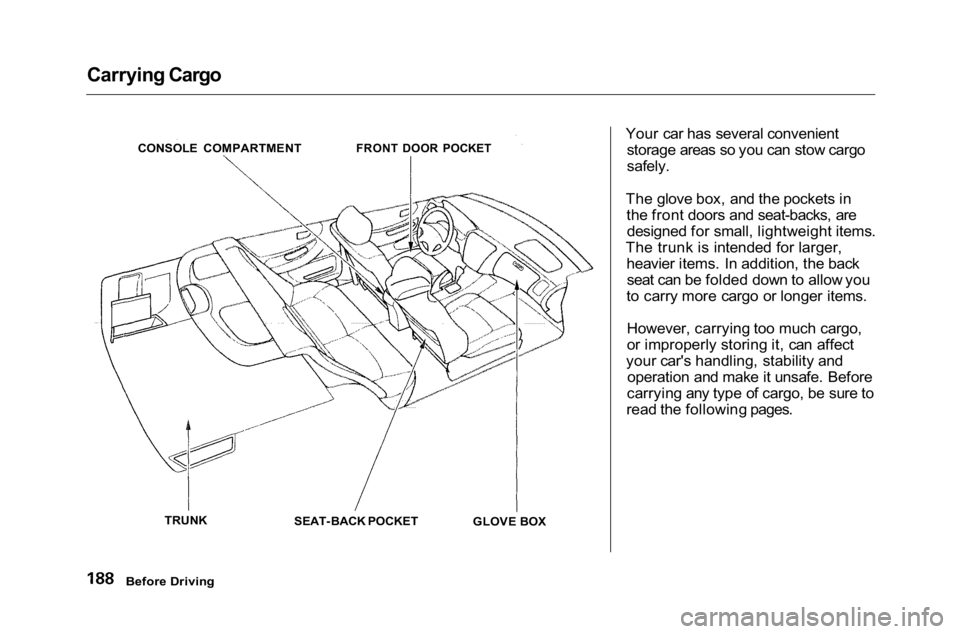
Carrying Cargo
Your car has several convenientstorage areas so you can stow cargo
safely.
The glove box, and the pockets in the front doors and seat-backs, aredesigned for small, lightweight items.
The trunk is intended for larger, heavier items. In addition, the backseat can be folded down to allow you
to carry more cargo or longer items.
However, carrying too much cargo,
or improperly storing it, can affect
your car's handling, stability and operation and make it unsafe. Before
carrying any type of cargo, be sure to
read the following pages.
Before Driving
CONSOLE COMPARTMENT
FRONT DOOR POCKET
SEAT-BACK POCKET GLOVE BOX
TRUNK
Page 192 of 372
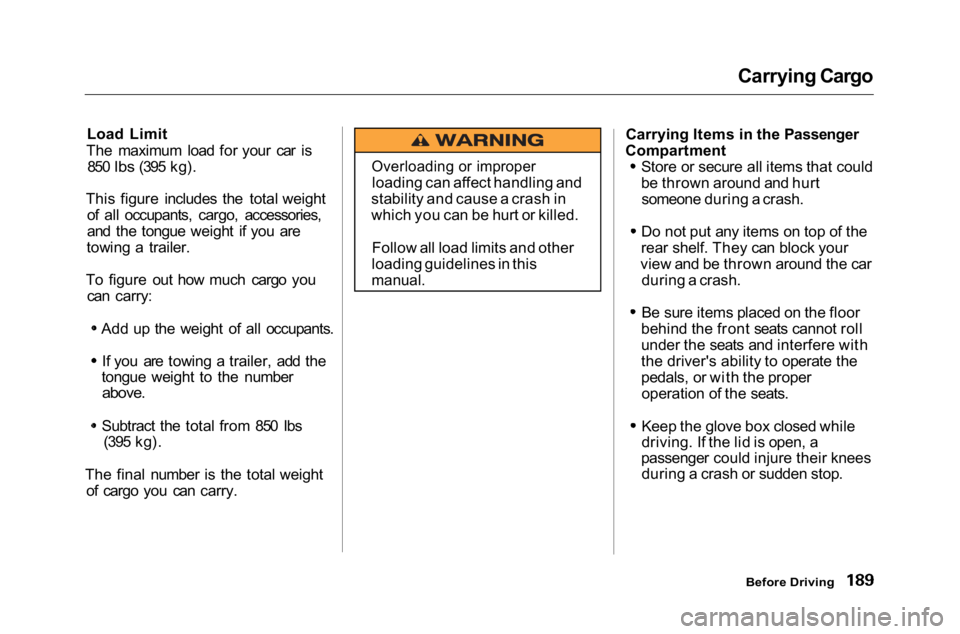
Carrying Cargo
Load Limit
The maximum load for your car is 850
lbs
(395 kg).
This figure includes the total weight of all occupants, cargo, accessories,
and the tongue weight if you are
towing a trailer.
To figure out how much cargo you can carry:
Add up the weight of all occupants.If you are towing a trailer, add the
tongue weight to the number
above.
Subtract the total from 850 Ibs (395 kg).
The final number is the total weight of cargo you can carry. Carrying Items in the Passenger
Compartment Store or secure all items that could
be thrown around and hurtsomeone during a crash.
Do not put any items on top of the
rear shelf. They can block your
view and be thrown around the car during a crash.
Be sure items placed on the floor
behind the front seats cannot roll
under the seats and interfere with
the driver's ability to operate the
pedals, or with the proper operation of the seats.
Keep the glove box closed while
driving. If the lid is open, a
passenger could injure their knees during a crash or sudden stop.
Before Driving
Overloading or improper
loading can affect handling and
stability and cause a crash in
which you can be hurt or killed.
Follow all load limits and other
loading guidelines in this
manual.
Page 193 of 372

Carrying Cargo
Carrying Cargo in the Trunk or on a Roof Rack
Distribute cargo evenly on the
floor of the trunk, placing the
heaviest items on the bottom and as far forward as possible.
If you fold down the back seat, tiedown items that could be thrown
about the car during a crash or
sudden stop.
If you carry large items that
prevent you from closing the trunk
lid, exhaust gas can enter the
passenger area. To avoid the possibility of carbon monoxide
poisoning, follow the instructions on page 49. If you can cany any items on a
roof rack, be sure the total weightof the rack and the items does not
exceed the maximum allowable
weight. Please contact your Honda dealer for further information.
Before Driving
Page 194 of 372

Driving
This section gives you tips on starting the engine under various
conditions, and how to operate the
5-speed manual and automatic
transmissions. It also includes important information on parking
your car, the braking system, and facts you need if you are planning to
tow a trailer.
Preparing to Drive......................... 192
Starting the Engine........................ 193
Starting in Cold Weatherat High Altitude ..................... 194
5-speed Manual Transmission..... 195 Recommended Shift Points...... 196
Engine Speed Limiter ............... 196
Automatic Transmission............... 196 Shift Lever Position Indicator.. 197
Shift Lever Positions................. 197
Engine Speed Limiter............... 200
Shift Lock Release..................... 200
Parking............................................ 202
The Braking System...................... 203 Brake Wear Indicators.............. 203
Brake System Design................ 204
Anti-lock Brakes........................ 204
Important SafetyReminders.......................... 205
ABS Indicator......................... 205
Traction Control System............... 206 TCS ON/OFF Switch................ 207
TCS Indicator............................. 207
Driving in Bad Weather................ 209
Towing a Trailer............................ 211
Driving
Page 195 of 372
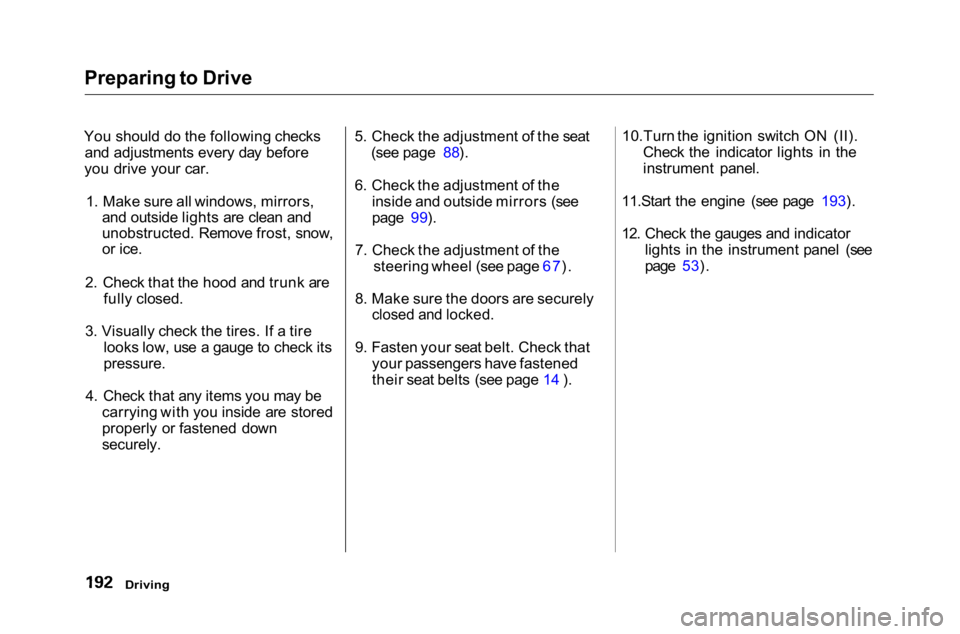
Preparing to Drive
You should do the following checks and adjustments every day before
you drive your car.
1. Make sure all windows, mirrors, and outside lights are clean and
unobstructed. Remove frost, snow,
or ice.
2. Check that the hood and trunk are fully closed.
3. Visually check the tires. If a tire looks low, use a gauge to check its
pressure.
4. Check that any items you may be carrying with you inside are stored
properly or fastened down
securely. 5. Check the adjustment of the seat
(see page 88).
6. Check the adjustment of the inside and outside mirrors (see
page 99).
7. Check the adjustment of the steering wheel (see page 67).
8. Make sure the doors are securely
closed and locked.
9. Fasten your seat belt. Check that your passengers have fastened
their seat belts (see page 14 ). 10.Turn the ignition switch ON (II).
Check the indicator lights in the
instrument panel.
11.Start the engine (see page 193).
12. Check the gauges and indicator lights in the instrument panel (see
page 53).
Driving
Page 196 of 372

Starting the Engine
1. Apply the parking brake.
2. In cold weather, turn off all electrical accessories to reduce
the drain on the battery.
3. Manual Transmission:
Push the clutch pedal down all the
way. START (III) does not
function unless the clutch pedal is
depressed.
Automatic Transmission:
Make sure the shift lever is in
Park. Press on the brake pedal. 4. Without touching the accelerator
pedal, turn the ignition key to theSTART (III) position. If the engine
does not start right away, do not
hold the key in START (III) for
more than 15 seconds at a time. Pause for at least 10 seconds
before trying again.
5. If the engine does not start within 15 seconds, or starts but stalls
right away, repeat step 4 with the accelerator pedal pressed half-way
down. If the engine starts, release
pressure on the accelerator pedal so the engine does not race. 6. If the engine still does not start,
press the accelerator pedal all the
way down and hold it there while starting in order to clear flooding.
As before, keep the ignition key in the START (III) position for no
more than 15 seconds. Return tostep 5 if the engine does not start.
If it starts, lift your foot off the
accelerator pedal so the engine
does not race.
Driving
Page 197 of 372

Starting the Engine
Starting in Cold Weather at High
Altitude (Above 8,000 feet/
2,400 meters)
An engine is harder to start in cold weather. The thinner air found athigh altitude above 8,000 feet (2,400meters) adds to the problem.
Use the following procedure:
1. Turn off all electrical accessories
to reduce the drain on the battery.
2. Push the accelerator pedal half- way to the floor and hold it therewhile starting the engine. Do nothold the ignition key in START (III) for more than 15 seconds.
When the engine starts, release the accelerator pedal gradually as
the engine speeds up and smoothsout.
3. If the engine fails to start in step 2, push the accelerator pedal to the
floor and hold it there while youtry to start the engine for no more
than 15 seconds. If the enginedoes not start, return to step 2.
Driving
Page 198 of 372
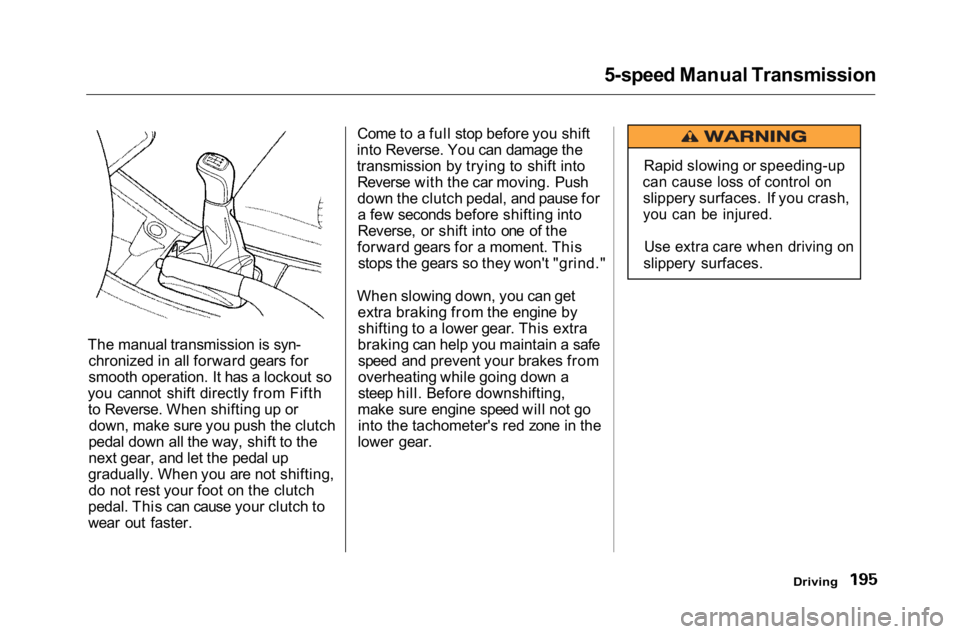
5-speed Manual Transmission
The manual transmission is syn- chronized in all forward gears for
smooth operation. It has a lockout so
you cannot shift directly from Fifth to Reverse. When shifting up or down, make sure you push the clutch
pedal down all the way, shift to the
next gear, and let the pedal up
gradually. When you are not shifting, do not rest your foot on the clutch
pedal. This can cause your clutch to
wear out faster. Come to a full stop before you shift
into Reverse. You can damage the
transmission by trying to shift into Reverse with the car moving. Push
down the clutch pedal, and pause fora few seconds before shifting into
Reverse, or shift into one of the
forward gears for a moment. This stops the gears so they won't "grind."
When slowing down, you can get extra braking from the engine byshifting to a lower gear. This extra
braking can help you maintain a safe speed and prevent your brakes from
overheating while going down a
steep hill. Before downshifting,
make sure engine speed will not go into the tachometer's red zone in the
lower gear.
Driving
Rapid slowing or speeding-up
can cause loss of control on
slippery surfaces. If you crash,
you can be injured.
Use extra care when driving on
slippery surfaces.
Page 199 of 372
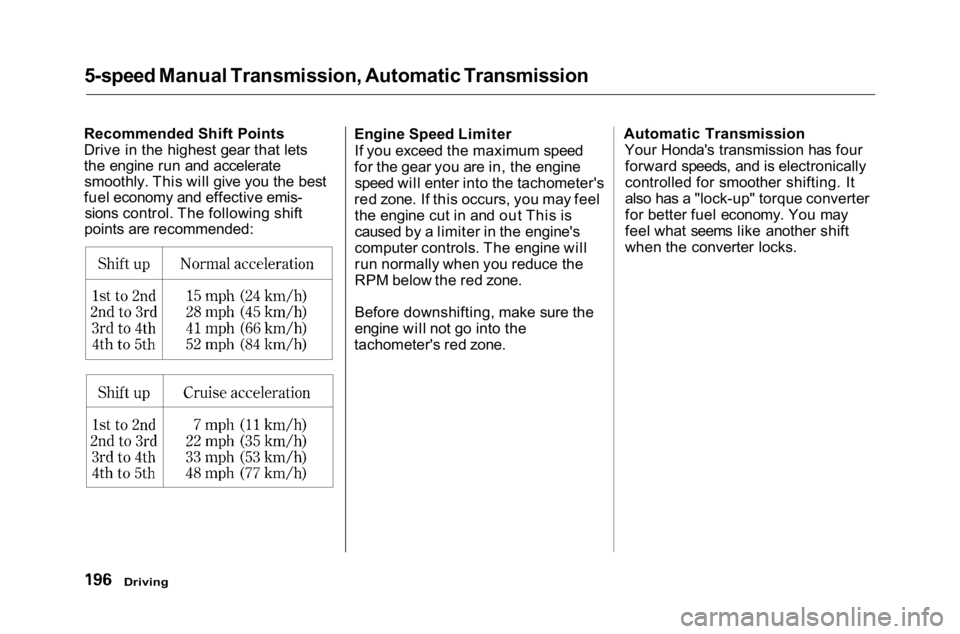
5-speed Manual Transmission, Automatic Transmission
Recommended Shift Points
Drive in the highest gear that lets
the engine run and accelerate smoothly. This will give you the best
fuel economy and effective emis- sions control. The following shift
points are recommended: Engine Speed Limiter
If you exceed the maximum speed
for the gear you are in, the engine speed will enter into the tachometer's
red zone. If this occurs, you may feel the engine cut in and out This is
caused by a limiter in the engine's
computer controls. The engine will
run normally when you reduce the
RPM below the red zone.
Before downshifting, make sure the
engine will not go into the
tachometer's red zone. Automatic Transmission
Your Honda's transmission has fourforward speeds, and is electronically
controlled for smoother shifting. It
also has a "lock-up" torque converter
for better fuel economy. You may
feel what seems like another shift
when the converter locks.
Driving
Page 200 of 372
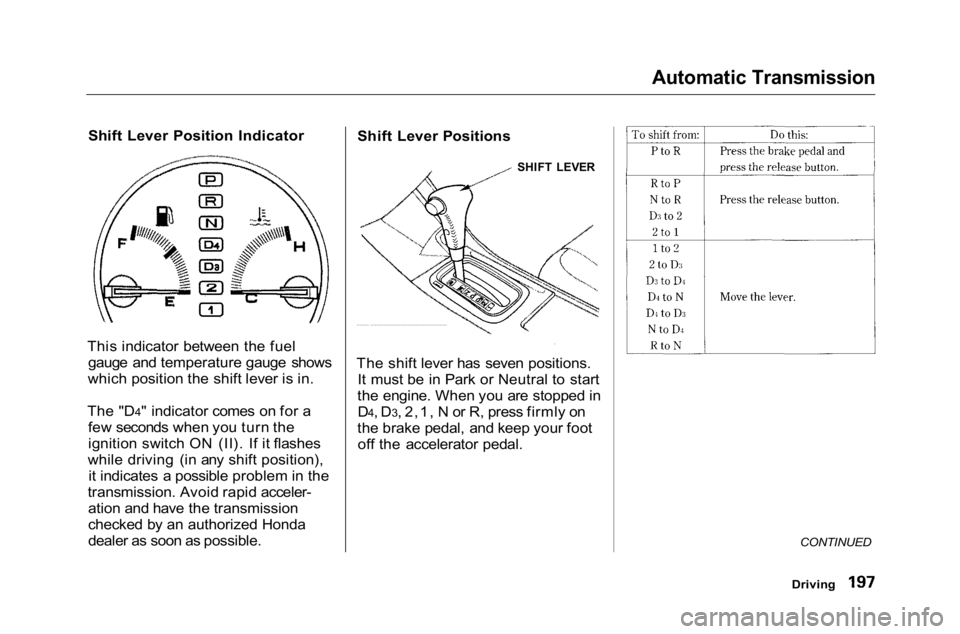
Automatic Transmission
Shift Lever Position Indicator
This indicator between the fuel gauge and temperature gauge shows
which position the shift lever is in.
The "D4" indicator comes on for a few seconds when you turn the
ignition switch ON (II). If it flashes
while driving (in any shift position), it indicates a possible problem in the
transmission. Avoid rapid acceler- ation and have the transmission
checked by an authorized Honda
dealer as soon as possible. Shift Lever Positions
SHIFT LEVER
The shift lever has seven positions. It must be in Park or Neutral to start
the engine. When you are stopped in D4, D3, 2,1, N or R, press firmly on
the brake pedal, and keep your foot off the accelerator pedal.
CONTINUED
Driving